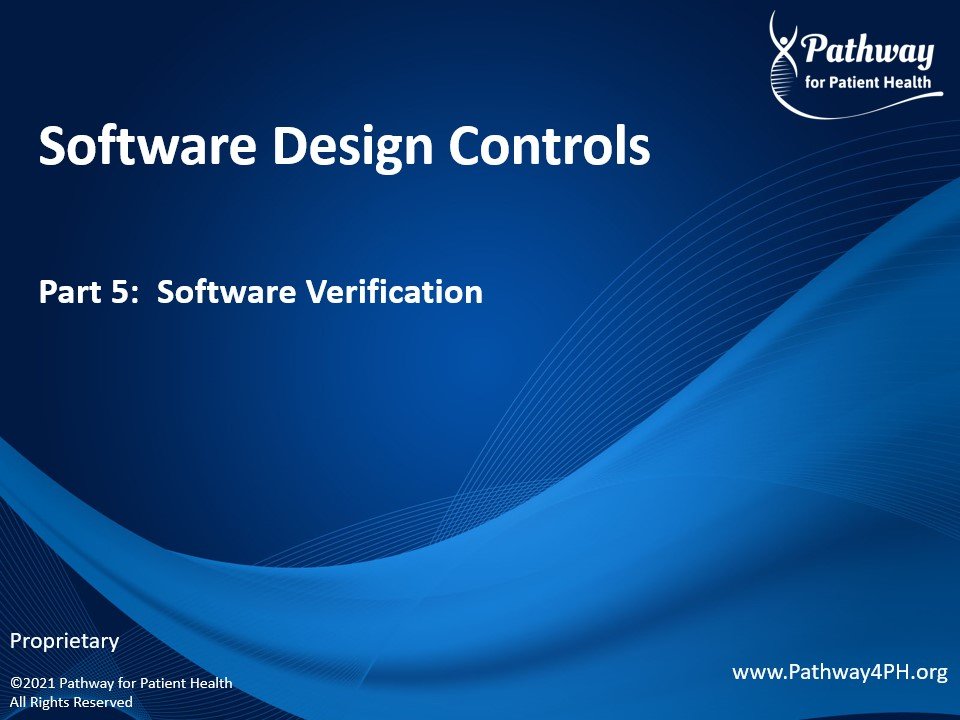Software Design Controls Badge
Why Software Design Controls? Digitalization has rapidly advanced our ability to diagnose and treat patients around the world. We are seeing software in medical device (SiMD) and even software as the medical device itsel (SaMD)! There has been a huge call for putting the reigns on the “wild west” and ensuring that our use of software is safe, effective and responsible. Applying the design control strategy of traditional medical devices to these digital products is proving to be the answer.
Who Should Enroll? The Software Design Control Badge is intended to be an advanced course recommended for professionals who already have a baseline understanding of traditional computer software validation, computer software assurance and medical device design controls.
What Will I Learn? Below, you will find each class listed with the Learning Objectives, Expert Instructors, and total course time needed to complete the program. You will learn how to navigate software complexities, integrate risk assessments, and ensure your product is designed with proper controls.
Digital Badge? Once you successfully complete the on-demand program, you will be awarded a Certificate of Completion and a Digital Badge that you can share on LinkedIn!
Attention Corporate Member Employees: You have free access to this Badge. Please login to the Corporate Member website to register, and feel free to contact Michelle.Rich@Pathway4PH.org if you need any help.
Interested in Corporate Membership where 100% of your employees can have unlimited access to over 120 courses and badges? Learn More!
Meet Your Expert Instructor!
The Curriculum:
Software Design Controls Badge: 10 Classes. 11 Videos. ~7.1 hours [.71 CEU]
Class 1: Introduction to Software Design Controls
Instructor: Eric Henry
Learning Objectives:
1. Become acquainted with various Software Design Controls terminology 2. Gain an appreciation of the complexity of global software regulation
Class 2: Software Development Planning
Instructor: Eric Henry
Learning Objectives:
Gain an appreciation of developing a Software Development Planning strategy
Understand some key elements to include in your plan
Recognize the importance of linking the plan to a traceability approach
Class 3: Risk Management - Parts 1 and 2
Instructor: Eric Henry
Learning Objectives:
Understand the importance of taking a holistic approach to Risk Management
Distinguish between varying levels of risk and harm
Understand P1 and P2
Class 4: Software Requirements, Architecture, and Design
Instructor: Eric Henry
Learning Objectives:
Understand the major levels of software design
Understand static means for verifying software design
Learn how to build traceability into software design
Class 5: Software Verification
Instructor: Eric Henry
Learning Objectives:
Understand the different levels of software verification
Understand the impact of traceability on software verification
Understand the test case structure in software verification
Class 6: Software Release, Validation and Traceability
Instructor: Eric Henry
Learning Objectives:
1. Understand the element of software release as distinct from design transfer
2. Understand software validation element for SaMD
3. Understand the importance and some mechanisms for full horizontal and vertical traceability
Class 7: Design Transfer and Maintenance
Instructor: Eric Henry
Learning Objectives:
1. Understand elements of design transfer specific to software
2. Understand the elements of a software maintenance plan
3. Understand the importance of and techniques for impact analysis during design change
Class 8: Software Problem Resolution
Instructor: Eric Henry
Learning Objectives:
1. Understand the elements of problem reporting
2. Understand the importance of problem trending
3. Understand the fallacy of zero-defect policies
Class 9: Legacy Software, Cybersecurity and Artificial Intelligence
Instructor: Eric Henry
Learning Objectives:
1. Understand how to integrate cybersecurity into design controls and risk management
2. Understand the regulatory requirements for cybersecurity
3. Understand AI/ML basics for medical devices
Class 10: Design Verification and Design Validation Knowledge Checks
Instructor: Eric Henry
Learning Objectives:
1. Understand key elements of design verification for SiMD/SaMD
2. Understand key elements of design validation for SiMD/SaMD
Pricing for On-Demand Badge - $300
Attention Corporate Member Employees: You have free access to this Badge. Please login to the Corporate Member website to register, and feel free to contact Michelle.Rich@Pathway4PH.org if you need any help.
Interested in Corporate Membership where 100% of your employees can have unlimited access to over 120 courses and badges? Learn More!
How Will You Access the Course?
All Badge Courses are on-demand and are accessed through Pathway’s Learning Management System - Canvas.
You will receive an email invitation from Canvas (notifications@instructure.com).
You will create a Canvas log-in used for all Badges you take through Pathway.
In Canvas, you will complete all classes in sequential order. After completing a quiz at the end of each class, the next class will be made available to you.
After completing your course, you will receive your Certificate of Completion, which you can share as a Digital Badge on LinkedIn!
Interested in More? Quality Operations Forum
for Year Round Learning
If you are a Site or Corporate Quality Professional, you are invited to join our Quality Operations Forum.
You will have many opportunities throughout the year to learn from your global peers, Chief Quality Officers and experts from our industry and beyond.
The purpose of the forum is to support you in proactively implementing successful practices gained through a vibrant network of global peers collaboratively addressing contemporary and complex challenges.
60+ World Cafe and External Intelligence meetings throughout the year are included!
Questions? Please contact Michelle Rich, our Director of Corporate Programs with any questions you might have.













